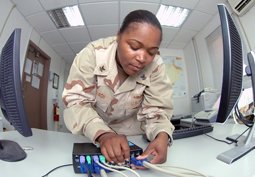By: Spencer Ackerman
For the first time, a sailor or Marine on board a ship out to sea can actually use his or her cellphone for something other than setting a wake-up alarm. In late March, Danger Room has confirmed, the Navy will send the USS Kearsarge and USS San Antonio to the Persian Gulf with its brand new 4G LTE network.
And the Navy’s already expecting uploaded flicks of pirates. It’s even passing out free Android phones.
The network, first reported by Danger Room last year, is a microwave-based wireless wide-area network (WWAN) that will augment the satellite-based communications on board the amphibious assault ship Kearsarge and the transport dock San Antonio. The final phase of testing for the system began on board both ships, off the mid-Atlantic coast, about two weeks ago and should finish by Feb. 20. (The dock landing ship Whidbey Island won’t carry the network as planned last year, Danger Room has learned.)
Between 300 and 400 sailors and Marines who go through training on the 4G LTE network will be equipped with LG smartphones running Android. The devices will facilitate calls, text, and data transfer between ships from up to 20 nautical miles’ distance; between decks on board the ships; and, critically, to relay data between Marine helicopters and the ships below.
Like, for instance, videos of pirates. Seriously.
“The air node will allow them to have a mobile air network. We want to test that for anti-piracy missions,” says Doug Abbotts, a spokesman for the Navy’s Naval Air Systems Command, which has been working on the network since 2009. “The air node goes over the suspected pirate [via the helicopter] and the people who are advancing on the pirates, so they can shoot video through sensors on the helicopters and that video can be transferred to the ship via the network, or transmitted to a patrol boat” responding to a pirate attack.
If the network works as intended, then the situational awareness involved in a pirate attack can filter down to individual sailors and Marines practically in real time. Indiana-based BATS Wireless, one of the companies hired to construct the network, told Danger Room last year it should be able to provide 300 megabits per second’s worth of data.
“That’s the whole idea,” Abbotts says: ensuring sailors and Marines “can see video on the phone.” Prepare for the inevitable YouTube uploads, even if pirate attacks in waters around Yemen and Somalia are on the decline.
But the ships won’t just be in the Middle Eastern waterways. The Kearsarge and the San Antonio will next join up with the Navy’s 6th Fleet in the Mediterranean later this year. By then, sailors and Marines should have swapped a lot of video over their new network.
2013 is turning out to be a big year for the U.S. military’s experimentation with data networks. In addition to the Navy deployment, two U.S. Army brigades that took the Army’s new WIN-T network for dismounted soldiers to Afghanistan will complete their deployment.



